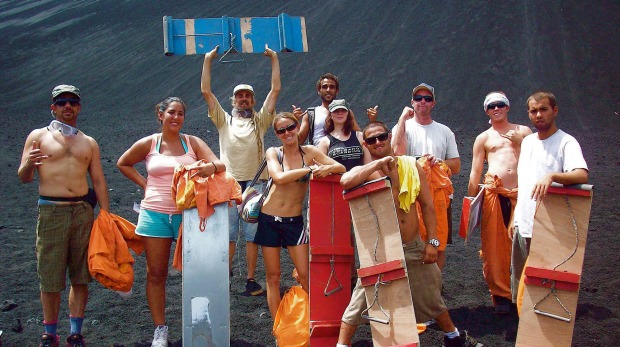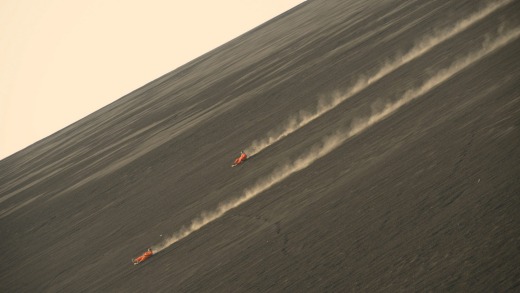
"We're not going that way," says Roger as I peer down into Cerro Negro's horseshoe-shaped crater. "That's the way the lava goes."
In 1971, one of the notorious Nicaraguan volcano's many eruptions caused the north-eastern section of the rim to collapse, and since then, the lava has followed the path of least resistance.
Prevailing winds, however, come from the opposite direction, meaning sand and ash is blown over the rim and towards the city of Leon. This means the Leon-facing slope is made up of relatively fine ash.

It's not totally smooth, but it is good enough for the adrenalin enthusiasts who have turned the slope into the venue for a new extreme sport. Cerro Negro is the home of volcano boarding, and while there are a few different ways to do it, all involve throwing yourself down a 650m slope at an angle of up to 41 degrees. Some do it surfer-style, standing up on crudely converted surf boards or specially fashioned planks of wood. But Roger and I are going to tackle it on what are basically sledges.
Volcano boarding began in 2003 when an Australian hostel owner in Leon decided that surfing could potentially work inland too, and the sport has grown steadily from there. After initially fighting against it, the Nicaraguan government and tourism authorities have begun to embrace it. It brings people to the area, after all, and you may as well charge them for access to the volcano.
What starts as novelty quickly becomes utterly terrifying.
I'm handed a marvellously unflattering jumpsuit, which will supposedly protect my clothes from getting filthy, and eye-protecting goggles. "Do not, whatever you do, take them off," Roger advises. There are also elbow pads and the sort of industrial-sized gloves more usually associated with glass-blowers.
It is serious kit, and it's clear that the descent is going to be no leisurely joyride. In fact, it's almost as if getting it wrong will result in excruciating pain.
There's only a limited amount of technique involved. There's a rope attached to the end of the board, and that needs to be held taut to prevent meandering changes of direction. To steer or slow down, it's simply a case of digging heels into the slope.
Unfortunately, all advice on braking seems to leave my brain shortly after I set off on the death plunge towards the bottom. It seems to get very fast and very steep, very soon.
What starts as novelty quickly becomes utterly terrifying. I'm under no illusion that I've got my perfunctory craft under any control – I'm just hanging on to it and praying that I'm not sent flying towards a grisly end.
It's also the world's most savage exfoliation treatment. The slope isn't quite as smooth as it appears from the top, and my face is attacked with an unceasing blizzard of volcano debris. The temptation is to scream, but that just induces a very unwelcome meal of grit.
The line between experience and ordeal is crossed about halfway down, and by the time I reach the bottom I've entered what can only be described as shellshock.
Roger runs over and asks if I'm OK. "That's the fastest I've ever seen someone go down first time. You were going at about 70km/h. Why didn't you brake?"
It is an excellent question, but one that can't be answered without spitting out half a volcano first.
See also: The top 10 high-speed travel experiences around the world